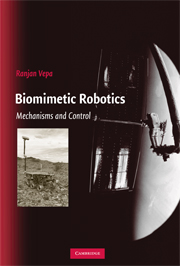Book contents
- Frontmatter
- Contents
- Preface
- Acronyms
- 1 The Robot
- 2 Biomimetic Mechanisms
- 3 Homogeneous Transformations and Screw Motions
- 4 Direct Kinematics of Serial Robot Manipulators
- 5 Manipulators with Multiple Postures and Compositions
- 6 Grasping: Mechanics and Constraints
- 7 Jacobians
- 8 Newtonian, Eulerian, and Lagrangian Dynamics
- 9 Path Planning, Obstacle Avoidance, and Navigation
- 10 Hamiltonian Systems and Feedback Linearization
- 11 Robot Control
- 12 Biomimetic Motive Propulsion
- Answers to Selected Exercises
- Appendix: Attitude and Quaternions
- Bibliography
- Index
8 - Newtonian, Eulerian, and Lagrangian Dynamics
Published online by Cambridge University Press: 20 February 2010
- Frontmatter
- Contents
- Preface
- Acronyms
- 1 The Robot
- 2 Biomimetic Mechanisms
- 3 Homogeneous Transformations and Screw Motions
- 4 Direct Kinematics of Serial Robot Manipulators
- 5 Manipulators with Multiple Postures and Compositions
- 6 Grasping: Mechanics and Constraints
- 7 Jacobians
- 8 Newtonian, Eulerian, and Lagrangian Dynamics
- 9 Path Planning, Obstacle Avoidance, and Navigation
- 10 Hamiltonian Systems and Feedback Linearization
- 11 Robot Control
- 12 Biomimetic Motive Propulsion
- Answers to Selected Exercises
- Appendix: Attitude and Quaternions
- Bibliography
- Index
Summary
Newtonian and Eulerian Mechanics
The kinematic synthesis of manipulators pointedly ignores one important aspect – size. It must be said that size matters! The parameter that is probably one of the best measures of size is inertia. The power required to drive a manipulator largely depends on the inertia of the manipulator. Thus the forces and moments that must be generated to ensure that the manipulator is not only mobile but performs the motions it is expected to take on a special significance. Yet there is one feature of the kinetics of mechanisms that sets it apart from the kinetics of free bodies. In the kinetic analysis of free bodies one is provided with the forces and moments acting on the body, and the objectives of the analysis are to determine the ensuing motions of the bodies. In the case of mechanisms the situation is just the opposite. The motions of all the kinematic links may be determined first, and it is then necessary to determine the forces and moments acting on each one of them. However, the basic principles of kinetic analysis remain the same. They all form a part of the field of dynamics, the study of the action of forces and moments on bodies and their relationship of the resulting motions. The study of the action of the forces and moments and the motions they generate relates to the kinetics whereas the relationships among the motion attributes, position, velocity, and acceleration relate to the kinematics.
Probably the primary underpinning principles of kinetic analysis are enshrined in Sir Isaac Newton's three laws of motion, which were enunciated in 1687 in the Principia Mathematica.
- Type
- Chapter
- Information
- Biomimetic RoboticsMechanisms and Control, pp. 142 - 163Publisher: Cambridge University PressPrint publication year: 2009

